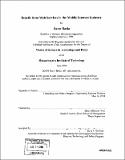| dc.contributor.advisor | Henry Birdseye Weil. | en_US |
| dc.contributor.author | Ikeda, Daizo, 1974- | en_US |
| dc.contributor.other | Massachusetts Institute of Technology. Technology and Policy Program. | en_US |
| dc.date.accessioned | 2005-09-06T21:17:34Z | |
| dc.date.available | 2005-09-06T21:17:34Z | |
| dc.date.copyright | 2004 | en_US |
| dc.date.issued | 2004 | en_US |
| dc.identifier.uri | http://hdl.handle.net/1721.1/27012 | |
| dc.description | Thesis (S.M.)--Massachusetts Institute of Technology, Engineering Systems Division, Technology and Policy Program, 2004. | en_US |
| dc.description | Includes bibliographical references (leaves 146-148). | en_US |
| dc.description.abstract | Over the past five years, mobile Internet services in Japan have seen major expansion as a result of collaboration between mobile operators acting as mobile portal providers, and their complementors, namely, content providers. However, the content business is currently under pressure to become profitable, and major players have found it difficult to differentiate their services from competitors In other words, service has become commoditized, which has resulted in a shift to the mature stage. This thesis suggests Web services as a solution to overcoming the commoditization of mobile Internet services and spurring new development in the industry. This emerging technology allows users to create a combination of Web resources through two fundamental approaches that lead to an innovation. The Web service requester approach enables integration of a variety of Web services as complementary assets from their business partners into their content. System Dynamics modeling methodology is used to examine how Web service requesters could promote product and process innovation as well as outsourcing. The analyses indicate that it is critical to adopt a different strategy under different scenarios of Web services diffusion, taking into consideration the requesters' dependence on Web service providers. The Web service provider approach offers an excellent opportunity to create distribution channels for services. Two case studies are analyzed in depth to understand how the subject companies took advantage of being a Web service provider with the support of complementors as well as users to promote innovation. Finally, suggestions are made for how the mobile industry value chain could evolve through Web services implementations, and policy | en_US |
| dc.description.abstract | (cont.) recommendations are offered for major stakeholders. Web services will likely enable close collaboration between players in the industry, including Web service providers, Web service requesters, and toolkit developers, all of which should see increasing value, which leads to further evolution of the mobile Internet industry. | en_US |
| dc.description.statementofresponsibility | by Daizo Ikeda. | en_US |
| dc.format.extent | 148 leaves | en_US |
| dc.format.extent | 6811736 bytes | |
| dc.format.extent | 6830890 bytes | |
| dc.format.mimetype | application/pdf | |
| dc.format.mimetype | application/pdf | |
| dc.language.iso | en_US | |
| dc.publisher | Massachusetts Institute of Technology | en_US |
| dc.rights | M.I.T. theses are protected by copyright. They may be viewed from this source for any purpose, but reproduction or distribution in any format is prohibited without written permission. See provided URL for inquiries about permission. | en_US |
| dc.rights.uri | http://dspace.mit.edu/handle/1721.1/7582 | |
| dc.subject | Technology and Policy Program. | en_US |
| dc.title | Benefit from Web services in the mobile Internet industry | en_US |
| dc.type | Thesis | en_US |
| dc.description.degree | S.M. | en_US |
| dc.contributor.department | Massachusetts Institute of Technology. Engineering Systems Division | |
| dc.contributor.department | Technology and Policy Program | |
| dc.identifier.oclc | 56726180 | en_US |
